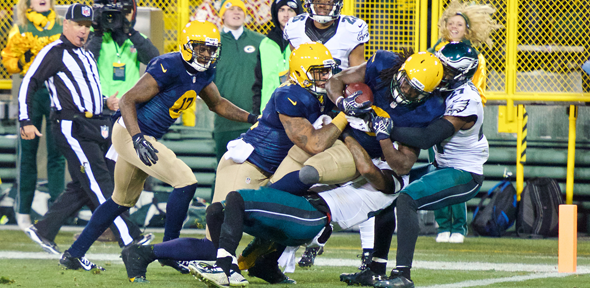
Researchers from Cambridge and Cardiff Universities are developing an origami-like material that could help prevent brain injuries in sport, as part of a programme sponsored in part by American football’s National Football League (NFL).
A number of universities and commercial companies are taking part in the NFL’s Head Health Challenge, which, as one of its goals, aims to develop the next generation of advanced materials for use in helmets and other types of body protection, for sport, military and other applications.
The Cambridge and Cardiff team are working in collaboration with helmet designer and manufacturer Charles Owen Inc, with funding support from the NFL, GE Healthcare, Under Armour and the National Institute of Standards and Technology, to develop and test their material over the next 12 months.
The Head Health Challenge competition is a $20 million collaborative project to develop new and innovative technologies in order to improve early-stage detection of mild traumatic brain injuries and to improve brain protection. The five-year collaboration is aiming to improve the safety of athletes, members of the military and society overall.
“The key challenge for us is to come up with a material that can be optimised for a range of different types of impacts,” said Dr Graham McShane of Cambridge’s Department of Engineering, who is part of the team behind the material. “A direct impact is different than an oblique impact, so the ideal material will behave and deform accordingly, depending on how it’s been hit – what we are looking at is the relationship between the material, geometry and the force of impact.”
In high-impact sports such as American football, players can hit each other with the equivalent of half a ton of force, and in an average game, there can be dozens of these high-impact blocks or tackles. More than 100 concussions are reported each year in the NFL, and over the course of a career, multiple concussions can do serious long-term damage.
The Head Health Challenge has created three separate challenges as part of its program of funding: Challenge I – Methods for Diagnosis and Prognosis of Mild Traumatic Brain Injuries; Challenge II – Innovative Approaches for Preventing and Identifying Brain Injuries; and Challenge III – Advanced Materials for Impact Mitigation. The C3 project is part of Challenge III. The various projects from Challenge III will have their efforts judged in a year’s time by a review panel, with the most promising technology receiving another $500,000 to develop the material further.
The multi-layered, elastic material developed by McShane and his colleagues at Cambridge and Cardiff, called C3, has been designed and tested using a mixture of theoretical and experimental techniques, so that it can be tailored for specific impact scenarios.

C3 has its origins in cellular materials conceived in the Department of Engineering for defence applications, and is based on folded, origami-like structures. It is more versatile than the polymer foams currently used in protective helmets, which are highly limited in terms of how they behave under different conditions.
Structures made from C3 can be designed in such a way that impact energy can be dissipated relatively easily, making it an ideal material to use in protective clothing and accessories.
Dr Peter Theobald, a Senior Lecturer at Cardiff University who is leading on the project, said: “Head injury prevention strategies have remained relatively stagnant versus the evolution of other technologies. Our trans-Atlantic collaboration with Charles Owen Inc. has enabled us to pool our highly relevant skills and expertise in injury prevention, mechanics, manufacturing and commercialisation.”
“This approach has already enabled us to develop C3 which, in the words of our evaluators, presents a potentially ‘game-changing’ material with great promise to better absorb the vertical and horizontal components of an oblique impact. This highly prestigious award provides us with a platform to continue developing C3 towards our ultimate goal of achieving a material that provides a step-change in head health and protection, whilst achieving metrics that ensure commercial viability.”
Inset image: Sample of C3. Credit: Cardiff University.
Adapted from Cardiff University press release.
Researchers are developing the next generation of advanced materials for use in sport and military applications, with the goal of preventing brain injuries.

The text in this work is licensed under a Creative Commons Attribution 4.0 International License. For image use please see separate credits above.